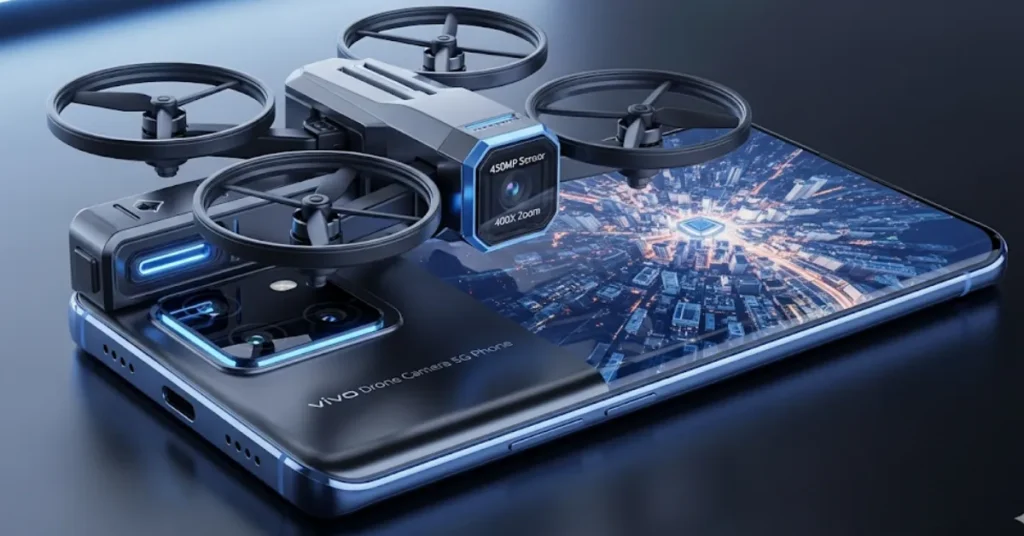Vivo has built a reputation for pushing the limits of smartphone technology, and the much-talked-about Vivo Drone Camera Phone continues to keep tech fans curious in 2025. Originally spotted in a 2020 patent filing, the idea of a detachable flying camera has fueled plenty of speculation. While several blogs have hinted at a market debut, no official statement has come from Vivo India or its global counterparts as of August 2025. This in-depth overview breaks down what such a device could offer, drawing insights from leaked renders, patents, and recent reports while keeping the Indian smartphone market in focus.

Futuristic Design and Display
Going by patent blueprints and concept illustrations, the Vivo Drone Camera Phone would sport a refined, premium build with a four-curve glass finish set in a sturdy aluminum frame. Expected color options may include Stellar Black, Aurora Blue, and Cosmic Silver, in line with Vivo’s current flagship palette. With dimensions close to 7.9mm in thickness and a weight of around 190 grams, the phone would be slim yet durable, featuring IP68 certification for water and dust resistance.
The front is expected to house a 6.9-inch Super AMOLED display with a silky-smooth 120Hz refresh rate, delivering FHD+ (2400×1080) resolution and up to 1000 nits brightness. Protected by Gorilla Glass 7, the panel would be nearly bezel-free with a 92% screen-to-body ratio, perfect for gaming and binge-watching. A wide slot at the top would accommodate the drone camera module, designed for seamless docking without compromising the viewing experience.
Innovative Drone Camera System
The phone’s highlight would be its detachable quadcopter camera system, built with four mini propellers and infrared sensors to detect obstacles. As per reports, the drone might include:
-
200MP primary camera (Zeiss optics, f/1.8) for ultra-clear aerial photos
-
32MP ultra-wide lens (f/2.2) for broader perspectives
-
16MP wide shooter and 5MP depth sensor for versatile captures
The drone would launch directly from the top of the device, controlled through the phone’s interface, making it ideal for aerial panoramas, wide group selfies, or cinematic videos. Core features could include HDR, Panorama, 20x zoom, and 4K video support. On the front, a 64MP in-display camera would handle selfies and video chats. Limitations, however, may arise due to its flight time of only 5–7 minutes and reduced stability in windy conditions.
Robust Performance
Powering this futuristic device could be Qualcomm’s Snapdragon 8 Gen 2 or MediaTek’s Dimensity 9200, with benchmarks close to 1.2 million on AnTuTu. Paired with 12GB LPDDR5 RAM and 256GB/512GB UFS 3.1 storage (expandable up to 1TB via microSD), the phone would easily handle multitasking and heavy gaming. A liquid-cooling setup would ensure smooth thermal management.
Running on Funtouch OS 15 based on Android 14, the device might include AI-driven enhancements like Smart Translate and AI Photo Optimizer. Vivo could also commit to 3 years of major updates and 4 years of security patches. Drone-specific controls would be fully integrated into the software, allowing intuitive flight management via the touchscreen.
Long-Lasting Battery
The handset is rumored to pack a massive 6900mAh battery capable of lasting 1.5–2 days on typical use, with around 6–8 hours of screen time. It may support 65W wired fast charging, refueling the device in about 40 minutes. A shared charging system would likely replenish both the smartphone and the drone simultaneously, though frequent drone flights could eat into battery reserves quickly than usual.
Connectivity and Features
Expected connectivity includes 5G (dual SIM with n77/n78 bands), Wi-Fi 6, Bluetooth 5.3, NFC, and GPS. The device may also come with dual stereo speakers, an IR blaster, and an in-display fingerprint scanner. The drone’s navigation system, enhanced by infrared proximity sensors, would improve in-flight safety, though DGCA restrictions in India might limit flying in certain zones.
Pricing and Availability
Speculations place the Vivo Drone Camera Phone between ₹69,999 and ₹88,350 for the 12GB/256GB variant. If released, it would likely be sold through Vivo India’s website, Amazon, Flipkart, and select offline retailers like Bajaj Finserv. Promotional offers could include no-cost EMI plans, exchange bonuses up to ₹5,000, and cashback schemes on specific bank cards. Service and maintenance would fall under Vivo’s existing nationwide service centers, but as of now, no confirmed launch date has been disclosed. Analysts suggest a possible rollout in late 2025 or early 2026.
Current Status and Challenges
Although portals like gadgetshigh.com and thedarbhanga.in claimed a 2024–2025 release, those reports are unverified. The design, first documented in a 2020 WIPO patent, still faces major obstacles such as compact drone battery life, durability, and compliance with India’s drone laws. High production costs also risk keeping it a niche product instead of a mainstream choice.
Final Thoughts
The Vivo Drone Camera Phone stands as one of the boldest smartphone concepts ever imagined, merging futuristic design with an aerial camera system. While its potential to redefine mobile photography is undeniable, the lack of official confirmation means its future remains uncertain. If launched, it would compete against premium flagships like Samsung Galaxy S25 and OnePlus 13 Pro, but success would depend on overcoming technical challenges and drone regulations. For vloggers, creators, and die-hard tech enthusiasts, this could be the ultimate dream gadget—provided it eventually becomes more than just a concept.
Hi, my name is Hussain, the author behind Nirmalahss. I’ve always been passionate about exploring the latest in technology and automobiles, and this platform is my way of sharing that passion with others. Over the years, I’ve followed new gadgets, software trends, and the ever-changing auto industry closely, which has helped me develop a strong understanding of what truly matters to everyday users.
